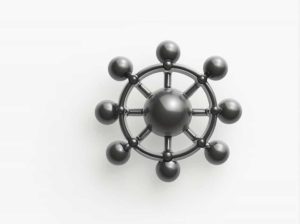Biochemical reactions are essential for life but many of them would occur too slowly without the help of catalytic molecules. These molecules known as enzymes play a crucial role in speeding up reactions and ensuring the proper functioning of biological processes.
This topic explores the definition structure functions and importance of enzymes in biochemical reactions.
What Are Catalytic Molecules in Biochemistry?
Catalytic molecules are substances that increase the speed of biochemical reactions without being consumed in the process. The most important group of catalytic molecules in biology is enzymes.
Definition of Enzymes
Enzymes are biological catalysts usually proteins that accelerate chemical reactions in living organisms. They help transform substrates (reactant molecules) into products by reducing the activation energy required for a reaction to occur.
Structure of Enzymes
Enzymes have a complex structure that allows them to bind to specific molecules and catalyze reactions efficiently. Their structure consists of:
1. Active Site
- The active site is the region of an enzyme where the substrate binds.
- It has a specific shape that matches the substrate following the lock-and-key model or induced fit model.
2. Apoenzyme and Cofactors
- Some enzymes need additional molecules to function.
- Apoenzyme: The inactive protein part of an enzyme.
- Cofactor: A non-protein molecule (metal ions or vitamins) that activates the enzyme.
3. Enzyme-Substrate Complex
- When a substrate binds to the active site it forms an enzyme-substrate complex leading to the reaction.
How Enzymes Work: Mechanism of Catalysis
Enzymes work by reducing the activation energy of a biochemical reaction. The process follows several steps:
- Substrate Binding: The substrate attaches to the enzyme’s active site.
- Formation of Enzyme-Substrate Complex: The enzyme holds the substrate in the correct position.
- Catalysis: The enzyme modifies the substrate converting it into the product.
- Product Release: The final product detaches from the enzyme.
- Enzyme Recycling: The enzyme remains unchanged and can catalyze more reactions.
Types of Enzymes and Their Functions
Enzymes are classified based on the type of reaction they catalyze.
1. Oxidoreductases
- Catalyze oxidation-reduction reactions (transfer of electrons).
- Example: Catalase (breaks down hydrogen peroxide into water and oxygen).
2. Transferases
- Transfer functional groups (e.g. phosphate methyl groups) between molecules.
- Example: Kinase (transfers phosphate groups in metabolic pathways).
3. Hydrolases
- Break chemical bonds using water.
- Example: Amylase (breaks down starch into sugars).
4. Lyases
- Catalyze the addition or removal of groups without water.
- Example: Decarboxylase (removes carbon dioxide from molecules).
5. Isomerases
- Convert molecules into their isomeric forms (same formula different structure).
- Example: Glucose-6-phosphate isomerase (converts glucose-6-phosphate to fructose-6-phosphate).
6. Ligases
- Join two molecules together often using ATP as an energy source.
- Example: DNA ligase (repairs DNA strands).
Factors Affecting Enzyme Activity
Enzymes are highly sensitive to environmental conditions. Several factors influence their activity:
1. Temperature
- Optimal temperature varies between enzymes.
- Too high or too low temperatures can cause denaturation (loss of function).
2. pH Level
- Most enzymes work best at a specific pH.
- For example pepsin (a stomach enzyme) functions best in an acidic environment while trypsin (found in the small intestine) works in a basic environment.
3. Substrate Concentration
- Increasing substrate concentration increases reaction speed until all enzymes are fully engaged.
4. Inhibitors
- Competitive inhibitors: Compete with the substrate for the active site.
- Non-competitive inhibitors: Bind to another part of the enzyme changing its shape and reducing activity.
Role of Enzymes in Biological Processes
Enzymes are involved in nearly all biological functions including:
1. Digestion
- Enzymes break down food molecules into absorbable nutrients.
- Example: Lipase (breaks down fats into fatty acids and glycerol).
2. Metabolism
- Enzymes regulate metabolic pathways such as glycolysis and the Krebs cycle.
- Example: Hexokinase (helps convert glucose into energy).
3. DNA Replication and Repair
- Enzymes play a crucial role in copying and repairing genetic material.
- Example: DNA polymerase (synthesizes new DNA strands).
4. Cellular Respiration
- Enzymes facilitate the production of ATP (energy).
- Example: Cytochrome c oxidase (part of the electron transport chain).
5. Immune Response
- Enzymes assist in breaking down pathogens.
- Example: Lysozyme (destroys bacterial cell walls).
Industrial and Medical Applications of Enzymes
Enzymes are not only important in biological systems but also have industrial and medical uses.
1. In Food Industry
- Used in cheese production brewing and baking.
- Example: Rennin (helps curdle milk in cheese-making).
2. In Medicine
- Used for disease treatment and diagnostics.
- Example: Streptokinase (used to dissolve blood clots).
3. In Biotechnology
- Used in genetic engineering and drug development.
- Example: Restriction enzymes (cut DNA at specific sites for genetic modification).
Molecules that catalyze biochemical reactions primarily enzymes are essential for life. They speed up reactions support metabolism aid in digestion and play crucial roles in medicine industry and biotechnology.
Understanding enzyme functions and factors affecting their activity helps in fields like biochemistry medicine and industrial applications. Their ability to accelerate reactions makes them indispensable in both biological systems and technological advancements.



